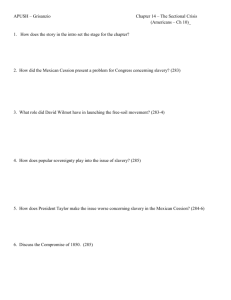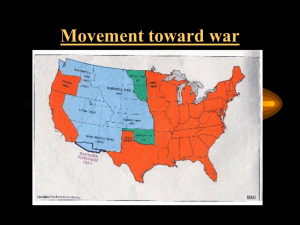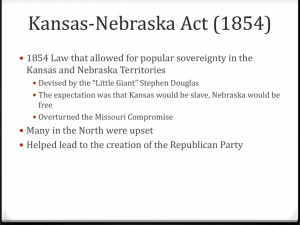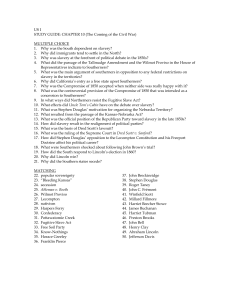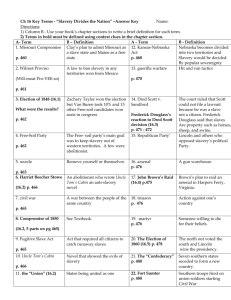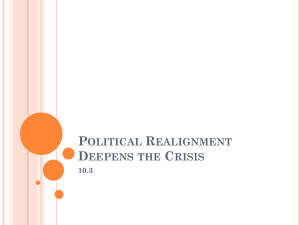Dred Scott Decision
advertisement
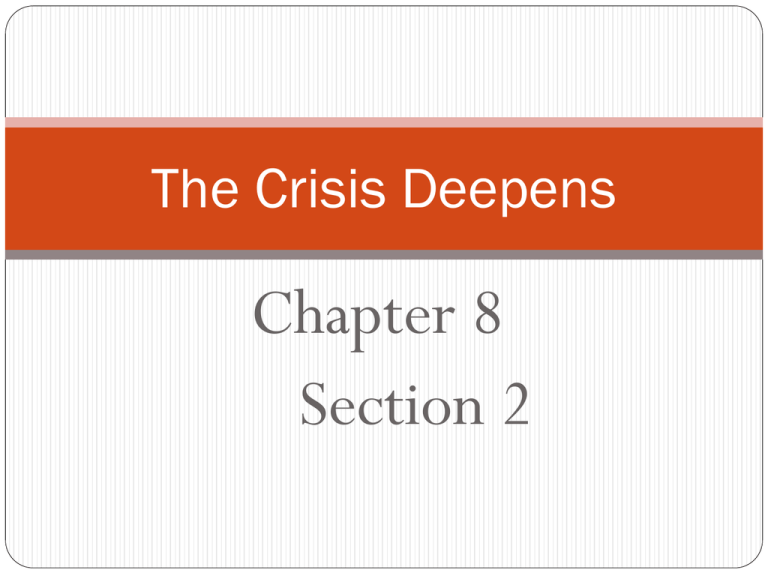
The Crisis Deepens Chapter 8 Section 2 New Political Parties Emerge By the end of 1856, the nation’s political landscape had drastically changed Whigs – split over slavery Northern Conscience Whigs Southern Cotton Whigs Democrats – alive – yet scarred – split over slavery Northern Democrats Southern Democrats A. Slavery Divided Whigs Founded in 1834 as a reaction to Andrew Jackson – long divided over the issue of slavery COTTON vs CONSCIENCE Division – issue over slavery Widening gap Election of 1852 & Fugitive Slave Act – Conscience Whigs supported Winfield Scott – Cotton whigs supported him to portray the union even though he supported fugitive slave act Democrat Franklin Pierce won the Election Final Demise – Kansas Nebraska Act B. NATIVISM – the favoring of native born people over immigrants Beliefs – Feared papal power – growing Catholicism Resisted the growth of immigrants Stronger immigration laws Order of the Star Spangled Banner Party created by the nativists – aka – American Party or Know Nothing Party Know Nothing Party – Anti - Catholic Opposed Immigration – Especially Catholic Immagration The “Know-Nothings” [The American Party] How is the issue of immigration different or the same today as it was in 1856? Anti –Slavery Parties Form A. Liberty Party – formed in 1844 – platform to pursue the cause of abolition by passing new laws ( effected the election of 1844 bt Clay & Polk) Free Soil Party – opposed the extension of slavery into the territories Chose Martin Van Buren in 1848 – failed to win any of the electoral vote – won 10% of popular vote ** NOT ABOLITIONISTS – objected to ending slavery on economic grounds – did not want slavery to extend 1852 Presidential Election √ Franklin Pierce Democrat Gen. Winfield Scott John Parker Hale Whig Free Soil 1852 Election Results Society’s Efforts to Stop Slavery “Underground Railroad” created by Harriet Tubman + conductors to evacuate slaves from South- almost 50,000 slaves saved by “railroad” Tubman rescued over 300 slaves after her escape The Issue of Slavery RACISM RULED throughout country Abolitionists racist by modern standards – Churches, schools, cemeteries wouldn’t accept them – workers didn’t trust them – worried about their own jobs Mistreated in South Girls used + sold as breeders for more slaves Southerners see their slaves as property, which could be moved with them to new lands Dred Scott Decision (1857) - FACTS: * Scott sued for his freedom. He claimed that he should be a free man since he lived in a free territory (WI) for four years. Dred Scott SUPREME COURT DECISIONS: Q: Was Scott a U.S. citizen with the right to sue? A: NO Q: Did living in a free territory make Scott a free man? A: NO Q: Did Congress have the right to outlaw slavery in any territory? A: NO RESULTS: • Dred Scott was not given his freedom. • The Missouri Compromise was found to be unconstitutional. Open to slavery through popular sovereignty (Compromise of 1850) Missouri Compromise line is declared unconstitutional (Dred Scott Decision) Open to slavery through popular sovereignty (KS-NE Act) How did the Dred Scott decision contribute to the growing split between North and South? C. JULY 6 1854 – the Republican party was organized in Jackson, Michigan – Members Free soilers Antislavery democrats Nativists Temperance supporters Beliefs Opposed the Kansas Nebraska Act Opposed the spread of slavery Bleeding Kansas Situation – Kansas was the first testing/ battling ground for new law “Bleeding Kansas” 1. March 1855 Kansas had enough to hold an election to establish territorial legislature David Atchinson Lecompton Constitution May 21, 1856 – Sack of Lawrence Pottawatamie Massacre Violence in the Senate – “Caning of Charles Sumner” “Bleeding Kansas” Lecompton Constitution A. Fall of 1857 – pro-slavery gov’t at Lecompton – wrote a constitution and applied for admission – (slave state) i. Kansas had 60,000 plus in pop. – however it was 10 to 1 in favor of freesoliers -- ii. President Buchannon endorsed the Lecompton Constitution iii. Stephen Douglas – outraged said it was against the Kansas/ Nebraska Act – allowed for popular sovereignty Douglas persuaded Congress to authorize another referendum on the Lecompton Constitution --- voters rejected the Constitution – Kansas will enter as a Free State – Douglas a hero Lincoln/ Douglas Debates 1858 race for Senate in the state of Illinois featured 2 term incumbent Stephen Douglas & former Whig Congressman now Republican Abraham Lincoln. ** to gain recognition Lincoln challenged Douglas to a series of 7 open air debates Douglas “Little Giant” Stocky and energetic Spoke with his hands, dramatically, pounding on the podium with fists, pacing dressed in sharp clothes, used impressive language Beliefs – believed that popular sovereignty was correct method in handling slavery Lincoln 6’4’’ tall, gangly , wore a stove piped hat, dressed in plain, rumpled clothes, former lawyer, politician, spoke in plain language Beliefs – believed slavery to be immoral/ “labor system based on greed” he was opposed to the spread of slavery – didn’t expect southerners to give up slavery 2nd Debate – Freeport, Illinois Freeport Doctrine – L – “Could the settlers of a territory vote to exclude slavery before that territory became a state?” (Dredd Scott) D – Slavery cannot exist a day or an hour anywhere, unless it is supported by local police regulations.” Douglas will win the Senate, but now some Republicans view Lincoln as an excellent candidate for Presidency. What were the Positions of Stephan Douglas and Abraham Lincoln on slavery? 1859 John Brown had dedicated his life to freeing the slave – leading a rebellion – it was his calling – and he believed the time to be ripe. October 16, 1859 – led a band of men black/ white into Harper’s Ferry, Va. Wanted to seize the Federal Arsenal Distribute arms to slaves No rebellion occurred – slaves were scared 8 of Brown’s men killed Couple of Days later – Col. Robert E. Lee killed 2 more men and captured Brown and his surviving men Brown was hanged December 2, 1859 John Brown’s Raid on Harper’s Ferry, 1859 In what ways might a Northerner and a Southerner view John Browns Action differently? Use the graphic organizer below to list the causes of the growing tensions between the south and the north Growing Tensions
